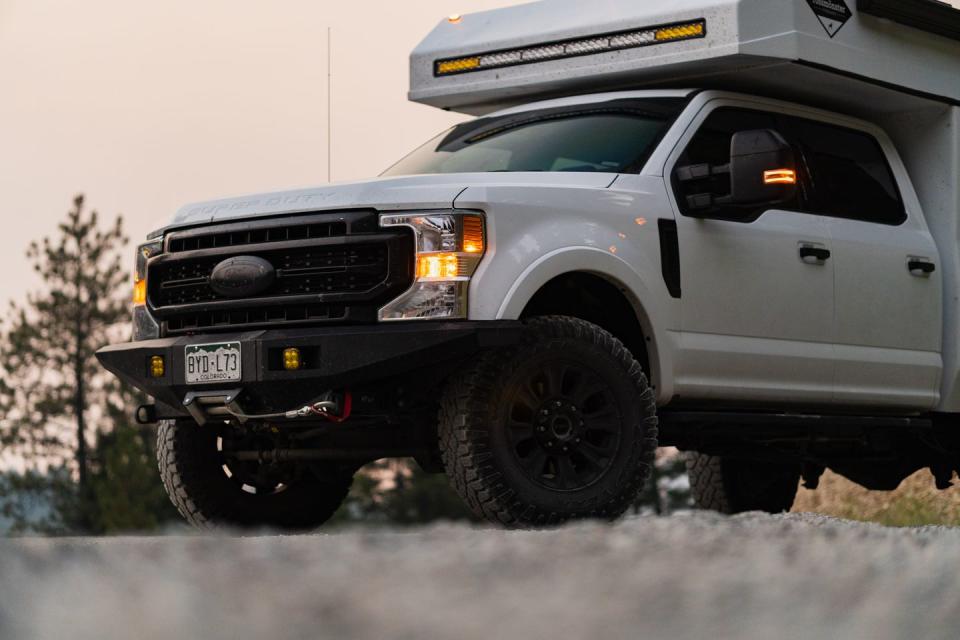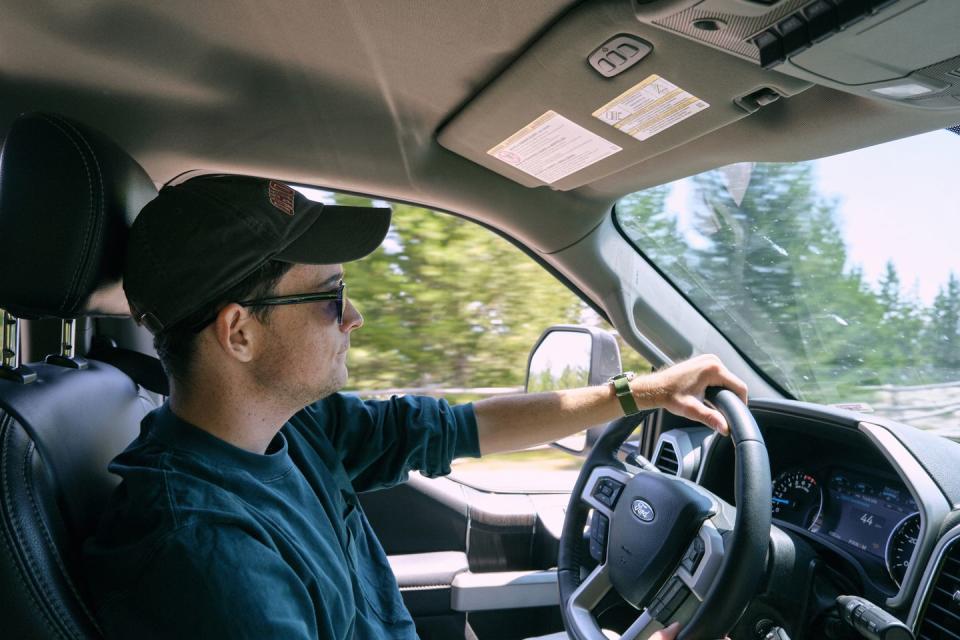The Rossmönster Baja Is Glorious Overlanding Overkill

Maybe it’s all theater. Big light bars, steel bumpers, knobby tires, electrically raising top, shiny technology and essential overlanding equipment designed to quickly capitalize on a trend. All presented to make you feel like the Rossmönster Baja is ready for everything. Standing before its looming presence, the impression itself certainly lands.
But maybe it comes from somewhere else.
Maybe the Baja is ready for just about anything. Over 2000 miles across three states, two national parks, and every type of road, that came to be the better-supported argument. The gargantuan F-250-based overland camper is about more than looking cool.

The fact that it looks cool is a mere side effect of the Baja being thoroughly thought-out. Consider the light bars, certainly over-the-top in a parking lot but life-saving on the road. Somewhere between Rossmönster Overland’s Longmont, Colorado headquarters and our first-night destination of Yellowstone National Park lies what must be the darkest road ever paved by man. In that midnight trek through rural Wyoming, I encountered about 30 such stretches of pavement contending for the title. These light bars are not street legal, but with 20-minute stretches between oncoming cars and the ability to spot them from five miles out, the crew and I figured some portable daylight was in the interest of safety.
Trundling through the night at 80 mph, I also came to appreciate the electrically raising roof on the F-250’s camper section. Despite the substantial wood floor, the fridge, and the running water, the Rossmönster never feels overburdened or sloppy. You’ll notice the weight under full-throttle acceleration or on twisting mountain roads, but on highways and surface streets the truck is seldom more intimidating than a normal pickup. The land most suited to these endless adventures happens to also be built for big trucks and campers, so clearance and width were never a problem.

In fact, we were able to secure a smaller plot in a Yellowstone campground long after the RV spots were all filled. Rolling in sometime after two in the morning with 550 miles already behind us, we were ready to collapse. The members of our group started the day in four different states, converged in Denver, and Ubered to Longmont. Then we covered most of Wyoming, all of Grand Tetons National Park, and the first hour of Yellowstone in complete and endless darkness. Campsite setup took only minutes. We popped the top, turned the dinner table into a one-person bed, and set up a makeshift fourth sleeping position in the cab.
That set the stage for what is undoubtedly the best part of camping. You don’t wake up and then drive to a beautiful place; you wake up in one. Tall pines and stillness surrounded us, with giant deer wandering through the site and the hazy buzz of a morning campground slowly creeping in. Everyone was getting ready for another day of adventure, the only option in these parts.

We reveled in the scenery for a moment before the power gauge brought us back to the practical part of reality. Running the heater had drained the battery below where it was supposed to be, so we fired up the truck and started hoped the alternator and solar cells would rejuvenate the power bank while the fridge and induction burner squeezed it for everything it had. The spacious refrigerator allowed for a bacon-and-eggs breakfast, though the lack of a grey water tank meant doing dishes in the campground sink.
Cabin space is at a premium during daylight hours, as the relatively narrow camper doesn’t allow for wide walkways. You’ll find yourself sandwiched between the sink on one side and the burner on the other. An articulating table should make sitting inside easier, but it pens you in a little too much to be comfortable. It’s usable for meals, but we ate outside every day instead.
Prepped for sleeping, the cabin easily accommodates three people. Trouble is, we had four. That meant two of us splitting the queen bed, another in the bed that converts from the table, and one in the cab. And since the pass-through to the camper section forced Rossmönster to forego a rear bench seat in favor of buckets, that fourth had to sleep on the F-250’s lumpy floor.
But the beauty of the Baja isn’t really in its function as a camper. It’s great for that, no doubt. There’s enough battery storage, solar panels, and energy from the engine that you can basically live indefinitely without a power hookup. There’s a big water tank and a hot outdoor shower. If you’d prefer it to the second bed, there’s a configuration with an indoor shower. There are clever cabinets, soft LED lighting, ample outlets to charge your gear, even integrated storage for the included dishes and cookware. None of these things, though, make it better than a van camper or a proper RV. The real advantage of the form comes in the Rossmönster’s prowess as a transport device.

Because right after breakfast, we were on the road again. Clean the dishes, lower the top, and seal the military-style rear hatch. That’s it. The beds don’t have to be made for the top to close, there are no stabilizers to raise, no hookups to detach unless you’re low on water. There’s no worry about whether your destination will have RV parking. Best of all, there’s no concern about whether your next destination will be on a road at all.
The Rossmönster just goes. Locking diffs, high-clearance bumpers, knobby tires, and a winch prepare you for extreme overlanding. A huge crew-cab cabin and plush seats allow cross-state journeys without an ounce of planning. You get the long-haul endurance and four-person space of a heavy-duty pickup cab (ours was an F-250 with the 7.3-liter "Godzilla" gas engine, but Rossmönster will build a Baja on the back of just about any truck) with the same simple living setup as a #vanlife rig. Wherever your trip heads, a truck camper like this maximizes options. You can negotiate fire roads or off-road paths and not worry about obstacles or park it downtown for a night out.

That kind of flexibility leads to the best adventures, the kind where you don’t have to be prepared for anything because you know the rig is prepared for you. It didn’t matter that we didn’t have campgrounds booked ahead of time. With no need to rely on shore power or water we could easily back-country camp in Flathead National Forest. It didn’t matter that there was no RV parking at the music festival or no room for campers the night we wanted to go to bars in downtown Whitefish, Montana. And it didn’t matter when, after four hours of sleep, we had to tackle the 15-hour drive back to Denver in one go. As a place to hang out, a place to sleep, and a tool for covering ground, the Rossmönster Baja simply let us do as much as possible in as much comfort as possible.
It’s not quite perfect; I personally would love space for four to sleep, a less finicky power-deploying rear hatch, and a little more attention to detail than the switchgear showed on our prototype tester. But none of those quibbles hold any real weight, even in my head. The Baja made it possible to take the sort of spectacularly beautiful free-form sleep-anywhere experience that I’ve always dreamed of. The idea of having even one more trip this perfect makes the absurdity of a $175,000 price tag look like a bargain. Because with all of the dream machines I’ve gotten to experience through this work, there isn’t one other vehicle I’ve wanted to keep as much as the Baja—not because of what it is, but because of where it can take me.

You Might Also Like

